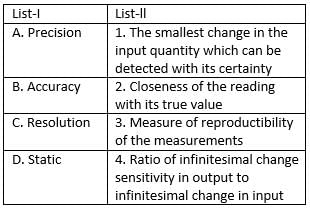Test: Electrical & Electronic Measurements- 1 - Electrical Engineering (EE) MCQ
10 Questions MCQ Test - Test: Electrical & Electronic Measurements- 1
Match List-I with List-ll and select the correct answer:


Match List-I (Bridge) with List-II (Parameter to be measured) and select the correct answer:

Codes:
A B C D
Which of the following are the characteristics of a thermocouple type of indicating instrument?
1. Its accuracy is very high, as high as about 1 percent
2. It has linear scale because a d'Arsonval movement is used for measuring the output.
3. It is a RF instrument and can be used for frequency up to about 50 MHz.
4. It cannot be damaged by overloads
Consider the following equations which can be derived from the ac bridges shown in the Figure 1 and Figure 2 by assuming ∆L/L = 0.1 and R = ωL :
1. V o1 = V o2
2. V o1 = 0.05 V s
3. V o1 = 0.1 V s
4. V o2 = 0.05 V s
5. V o2 = 0.1 V s
The correct derived equations from these figures of ac bridges are
In a single-phase power factor meter the controlling torque is
A dc circuit can be represented by an internal voltage source of 50V with an output resistance of 100 kΩ. In order to achieve accuracy better than 99% for voltage measurement across its terminals, the voltage measuring device should have a resistance of at least
In electrodynamometer type wattmeters, the inductance of pressure coil produces error. The error is
An ac voltmeter using full-wave rectification and having a sinusoidal input has ac sensitivity equal to
Time division multiplexing is used when the data to be transmitted is
If an induction type energy meter runs fast, it can be slowed down by



















